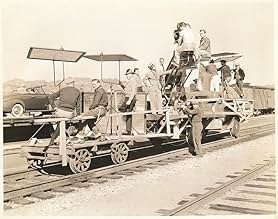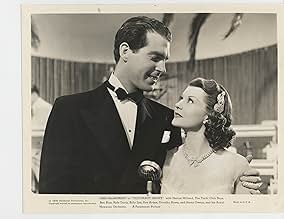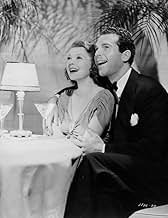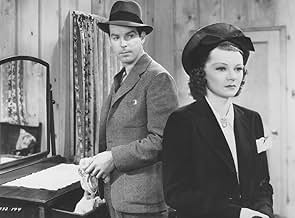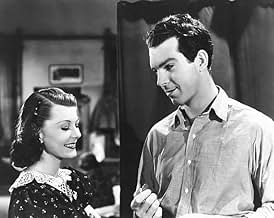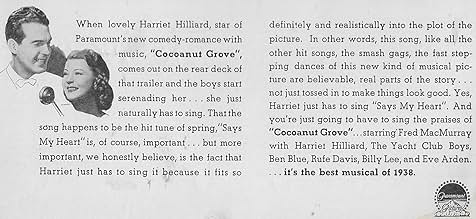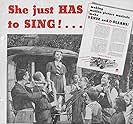Ajouter une intrigue dans votre langueBand tries to get an audition for a job at a prestigious nightclub.Band tries to get an audition for a job at a prestigious nightclub.Band tries to get an audition for a job at a prestigious nightclub.
Harriet Nelson
- Linda Rogers
- (as Harriet Hilliard)
Virginia Vale
- Hazel De Vore
- (as Dorothy Howe)
Charles Adler
- Member Yacht Club Boys
- (uncredited)
Murray Alper
- Concessionaire
- (uncredited)
Stanley Andrews
- Truant Officer
- (uncredited)
Monte Blue
- Undetermined Role
- (uncredited)
Egon Brecher
- Pawnbroker
- (uncredited)
Histoire
Le saviez-vous
- AnecdotesParamount sent photographers to the Cocoanut Grove to prepare a record of the Grove for the set designers to re-create the Cocoanut Grove interior on a Paramount sound stage.
- Citations
Linda Rogers: The bigger the fire, the better I look. In fact, during the Chicago fire, I was a ravishing beauty.
- ConnexionsReferenced in Lady of Burlesque (1943)
Commentaire en vedette
"Cocoanut Grove" is one of dozens of movies made in the 1930s through the 1950s about band leaders and their bands, life on the road of musical entertainment, and the competition and climb to fame and a name. Most of the later films were biopics about the most famous musicians, their bands and their distinctive "sound." The most famous of these is "The Glenn Miller Story" of 1953. But many other bands and their leaders had biopics made or were featured in film. Among those are Benny Goodman, Harry James, Louis Armstrong, Tommy and Jimmy Dorsey, Duke Ellington, Artie Shaw, Count Basie, Les Brown, Lionel Hampton, Gene Krupa, and Red Nichols and his Five Pennies.
But this film is in the earlier batch of fictional stories with a dance or swing band theme. It's a decent enough movie, and has some entertaining skits and numbers. The star, Fred MacMurray has a role that he may have had for life, if not for his acting career. MacMurray was raised in a musical home and learned to play a number of instruments. In college and afterwards, he played saxophone and clarinet in bands, and he also sang. Fred gets to do a little of both in "Cocoanut Grove," as he leads his Johnny Prentice Band.
The music isn't particularly great - nothing on the order of Miller, James, Ellington, Goodman or the Dorsey's. But it's good and it's complemented with some good acts. The Yacht Club Boys have a couple of dynamite numbers, one with a skit dressed as the Four Musketeers. And Eve Arden and Ben Blue have a couple of very good and amusing dance skits.
This film has some notable aspects that should be of particular interest to movie and music aficionados as well as students. The band playing in the Cocoanut Grove - ostensibly Johnny's band, is the Royal Hawaiian Orchestra, led by Harry Owens. Owens plays the part of Hula Harry, Johnny's piano player and a composer and song-writer he didn't seem to know he had until Linda Rogers (played by Harriet Nelson) came along.
Harry Owens in a story unto himself. He was a trumpet player with various bands at the Cocoanut Grove in the early 1930s. After hearing an island melody, he became interested in writing and playing music of the islands. He went to Honolulu and soon became the creator of the sounds of Hawaii for which it is known and identified with today. And, Owens is an Oscar winner, for the best original song in 1937, "Waikiki Wedding," which Bing Crosby sang in the movie of that title.
Another thing of note in this film is the performance of Billy Lee who plays Half Pint. He had just turned nine years old a couple months before this movie came out. And, could he knock out a beat and play some fine percussion on the drums!
Also notable is the setting for the end of the film - the famous Cocoanut Grove of Los Angeles. Although the movie was filmed on the Paramount lots, the set was built to resemble the actual Cocoanut Grove in the Ambassador Hotel. The Grove was the most prominent night club of Los Angeles for much of the 20th century - from 1921 to 1989. And, the Ambassador Hotel was the residence of half a dozen Presidents on tour and visits to LA. It also hosted the Academy Awards for several years in the late 1930s through early 1940s. The Ambassador Hotel closed in 1989, and most of the hotel and adjoining buildings were demolished in 2005.
This film is a good light comedy romance with some entertaining music and skits. And, for comedy, it also is just one of a few that have a very long exchange of almost nonsensical dialog that is very funny. Most people sitting in the theater wouldn't have been able to catch it all, but the advantage of modern technology and playback made it possible to catch all this dialog, with some effort. Here it is:
Johnny, "I wanna ask you something." Linda, "Well, go ahead." Johnny, "I, I don't mean now." Linda, "Well, then why bring it up?" Johnny, "Well, I don't think this is the place." Linda, "What's the matter with this place?" Johnny, "It's all right, but I'd rather ask you on the night without you asking." Linda, "Well, what was it you wanted to ask me?" Johnny, "If I tell you, I might as well ask you. But look, there is something I wanna tell ya, even if something happens and... I don't ask ya." Linda, "Johnny, you're not making any sense." Johnny, "W, well, what I'm tryin' to tell you is that, well, I don't seem to be able to say what I wanna tell you without being able to say what I don't wanna say." Linda, "You seem to be a little bit involved.
And, one more line for closing. Linda, "The bigger the fire, the better I look. In fact, during the Chicago fire, I was a ravishing beauty."
But this film is in the earlier batch of fictional stories with a dance or swing band theme. It's a decent enough movie, and has some entertaining skits and numbers. The star, Fred MacMurray has a role that he may have had for life, if not for his acting career. MacMurray was raised in a musical home and learned to play a number of instruments. In college and afterwards, he played saxophone and clarinet in bands, and he also sang. Fred gets to do a little of both in "Cocoanut Grove," as he leads his Johnny Prentice Band.
The music isn't particularly great - nothing on the order of Miller, James, Ellington, Goodman or the Dorsey's. But it's good and it's complemented with some good acts. The Yacht Club Boys have a couple of dynamite numbers, one with a skit dressed as the Four Musketeers. And Eve Arden and Ben Blue have a couple of very good and amusing dance skits.
This film has some notable aspects that should be of particular interest to movie and music aficionados as well as students. The band playing in the Cocoanut Grove - ostensibly Johnny's band, is the Royal Hawaiian Orchestra, led by Harry Owens. Owens plays the part of Hula Harry, Johnny's piano player and a composer and song-writer he didn't seem to know he had until Linda Rogers (played by Harriet Nelson) came along.
Harry Owens in a story unto himself. He was a trumpet player with various bands at the Cocoanut Grove in the early 1930s. After hearing an island melody, he became interested in writing and playing music of the islands. He went to Honolulu and soon became the creator of the sounds of Hawaii for which it is known and identified with today. And, Owens is an Oscar winner, for the best original song in 1937, "Waikiki Wedding," which Bing Crosby sang in the movie of that title.
Another thing of note in this film is the performance of Billy Lee who plays Half Pint. He had just turned nine years old a couple months before this movie came out. And, could he knock out a beat and play some fine percussion on the drums!
Also notable is the setting for the end of the film - the famous Cocoanut Grove of Los Angeles. Although the movie was filmed on the Paramount lots, the set was built to resemble the actual Cocoanut Grove in the Ambassador Hotel. The Grove was the most prominent night club of Los Angeles for much of the 20th century - from 1921 to 1989. And, the Ambassador Hotel was the residence of half a dozen Presidents on tour and visits to LA. It also hosted the Academy Awards for several years in the late 1930s through early 1940s. The Ambassador Hotel closed in 1989, and most of the hotel and adjoining buildings were demolished in 2005.
This film is a good light comedy romance with some entertaining music and skits. And, for comedy, it also is just one of a few that have a very long exchange of almost nonsensical dialog that is very funny. Most people sitting in the theater wouldn't have been able to catch it all, but the advantage of modern technology and playback made it possible to catch all this dialog, with some effort. Here it is:
Johnny, "I wanna ask you something." Linda, "Well, go ahead." Johnny, "I, I don't mean now." Linda, "Well, then why bring it up?" Johnny, "Well, I don't think this is the place." Linda, "What's the matter with this place?" Johnny, "It's all right, but I'd rather ask you on the night without you asking." Linda, "Well, what was it you wanted to ask me?" Johnny, "If I tell you, I might as well ask you. But look, there is something I wanna tell ya, even if something happens and... I don't ask ya." Linda, "Johnny, you're not making any sense." Johnny, "W, well, what I'm tryin' to tell you is that, well, I don't seem to be able to say what I wanna tell you without being able to say what I don't wanna say." Linda, "You seem to be a little bit involved.
And, one more line for closing. Linda, "The bigger the fire, the better I look. In fact, during the Chicago fire, I was a ravishing beauty."
- SimonJack
- 10 avr. 2021
- Lien permanent
Meilleurs choix
Connectez-vous pour évaluer et surveiller les recommandations personnalisées
Détails
- Date de sortie
- Pays d’origine
- Langue
- Aussi connu sous le nom de
- Quando Canta o Coração
- Lieux de tournage
- société de production
- Consultez plus de crédits d'entreprise sur IMDbPro
- Durée1 heure 25 minutes
- Couleur
- Rapport de forme
- 1.37 : 1
Contribuer à cette page
Suggérer une modification ou ajouter du contenu manquant

Lacune principale
By what name was Cocoanut Grove (1938) officially released in India in English?
Répondre
